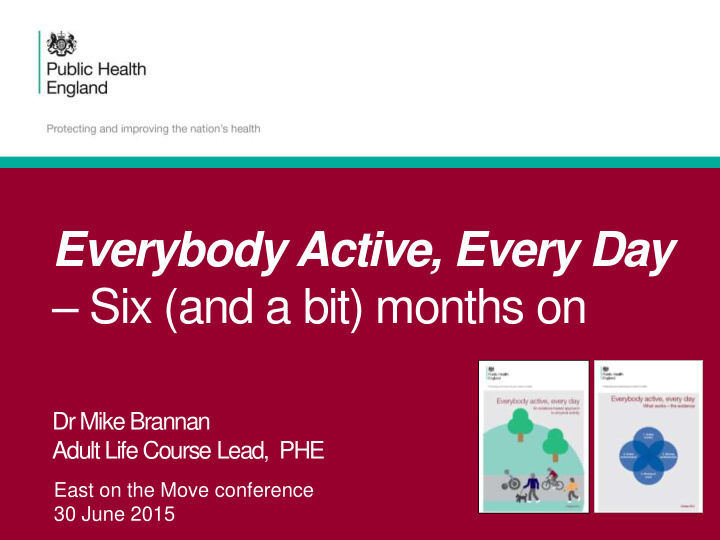



Everybody Active, Every Day – Six (and a bit) months on Dr Mike Brannan Adult Life Course Lead, PHE East on the Move conference 30 June 2015
Inactivity is killing us • Decreasing activity levels since 1960s: o Over 20% less physically active o Estimated 35 %↓ by 2030 ? • Physical inactivity is responsible for: o 1 in 6 UK deaths o Up to 40% of many long-term conditions • Estimated £7.4 billion annual cost Sources: Ng SW, Popkin B (2012); Lee I-M, et al. (2012); Wen CP, Wu X (2012); WHO (2010); Ossa D & Hutton J 2 (2002); Murray et al. (2013)
Everybody needs to be more active every day Source: Health Survey for England 2012 (HSE); Active People Survey 8, April 2103-April 2014 (APS); National Travel 3 Survey July 2014 (NTS)
The lazy man of the western world? International comparison of physical inactivity (at ages 15 and over) Holland, 18.2% Germany, 28.0% France, 32.5% Finland, 37.8% Australia, 37.9% USA, 40.5% UK, 63.3% 0.0% 10.0% 20.0% 30.0% 40.0% 50.0% 60.0% 70.0% % Inactive Note: Comparator = Not meeting any of the following per week: (a) 5 x 30 mins moderate-intensity activity; (b) 3 x 20 mins vigorous-intensity activity; (c) equivalent combination achieving 600 metabolic equivalent-min. Source: Hallal PC, Andersen LB, Bull FC, Guthold R, Haskell W, Ekelund U, for the Lancet Physical Activity Series Working 4 Group (2012) Global physical activity levels: surveillance progress, pitfalls, and prospects. The Lancet ; published online July 18.
Everybody Active Every Day • Consolidates international evidence and co-produced with over 1,000 local and national stakeholders • Supports local leaders to reframe, refocus and provide leadership on: o Cross-sector partnership o Industrial scale action across the whole system o Focus on addressing inactivity as well as increasing physical activity to health enhancing levels • Four domains for national and local action 5
1. Active society – Creating a social movement • Changing general attitudes to make physical activity the expectation or social norm • Working across sectors in the places we live and work • Developing a common vision of: “Everybody Active, Every Day” 6
Activities to date • Visible National leadership o Cross-government Ministerial & Officials groups o Strong cross-sectoral engagement • National campaigns with local tailoring o Change4Life o Adult behaviour change programme (in development) • Media & communications approach o PHE blogs & Twitter o Infographics o Targeted trade press 7
2. Moving professionals – Activating networks • Utilising existing network of influencers on the public, the public & voluntary sector workforce • ‘Making every contact count’ across sectors and disciplines • Starting with expertise & leadership in key sectors : o Education o Sports & leisure o Health & social care o Planning, design, transport 8
Activities to date • Healthcare professionals • Undergraduate spiral curriculum for medical & nursing schools led by Nottingham university • Free BMJ e-learning modules on physical activity & long term conditions & motivational interviewing skills • Expanding peer-to-peer Clinical Champions programme • Developing similar curricula and activation approaches for: • Sports & Leisure professionals • Teachers • Planners & architects • Toolkit for Members of Parliament 9
3. Active environments – Creating the right spaces • Developing ‘healthy’ cities, villages, towns and communities • Linking across disciplines through planning and policy : o ‘Active’ infrastructure planning o Capital funding investments • Embedding activity for all : o Age-friendly o Disability-friendly 10
Activities to date • Transport and Health briefing paper for travel planners will be published in Summer 2015. • Commissioned specific projects looking at rural active travel interventions and functional walking in people with disabilities. • Working with Active Travel Consortium group on developing infrastructure recommendations 11
4. Moving at scale – Interventions that make us active • Positive change must happen at every level and must be measurable, permanent and consistent • Implement ‘what works’ at scale • Maximise existing assets : o Human o Physical 12
Activities to date • Direct support to local partnerships through Centre teams • Sub-national embedding events • Standard Evaluation Framework training programme • Data and evidence briefings • Updated NHS cost of inactivity tool 13
Evidence for implementation • Synthesis of existing evidence base (e.g. NICE) • Evidence-based actions across public health system : o Settings o Life-course • Includes five key steps for local action : 1. Every child to enjoy & have skills to be active 2. Safe, attractive & inclusive active living environments 3. Make every contact count in public & voluntary sectors 4. Lead by example in public sector workspace Evaluate and share ‘what works’ 5. 14
Making it real in the East of England 1. Understand the challenge o 42% (38% to 48%) not active enough o 27% (23% to 31%) ‘physically inactive’ 2. Recognise & maximise assets & opportunities Networks – e.g. LA commissioners, Alliance o Initiatives – e.g. referral pathways, integrated o services, Year of cycling / Walking New approaches – e.g. GHGA pilots o 3. Long-term cross-sector commitment and collaboration for tangible, sustainable action 15
Let’s get Everybody Active Every Day! Michael.brannan@phe.gov.uk
Recommend
More recommend